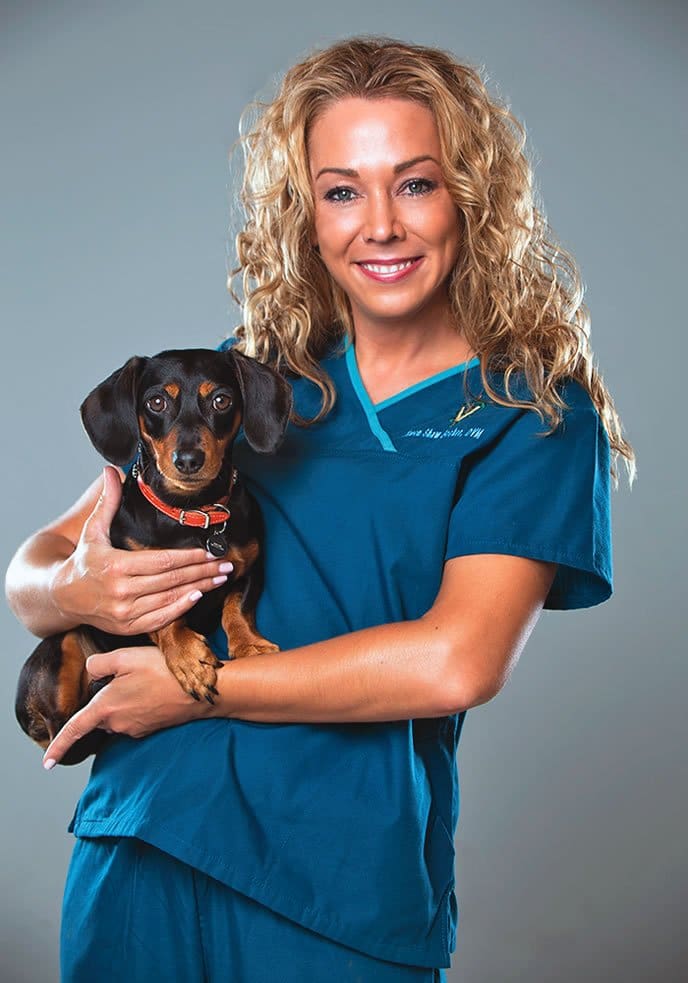I couldn’t be more excited to introduce this new column in Whole Dog Journal. I’ve been wanting to find someone to write a regular column about home-prepared cooked and raw diets for WDJ, but no one I’ve discussed it with and proposed it to has been able to commit to the amount of work it’s going to take. Allow me to emphasize the part of that previous sentence that finally opened the door to presenting the column: the phrase no one. You see, several of the people I spoke with were willing to provide some of the work of the column. What I needed to do was to build a team of like-minded and experienced home-prepared diet formulators and raw-diet feeders who could collaborate on the creation of diet guidelines and analysis of products and recipes prepared by other formulators.
Happily, a sort of canine-diet dream team has come together to work on a series of articles that will help owners formulate healthier home-prepared diets for their dogs – or identify the commercial raw diets (fresh, frozen, or dehydrated) that are genuinely nutritionally “complete and balanced” (in contrast to the vast majority that claim to be complete and balanced, but have potentially serious nutrient overages, deficiencies, or imbalances).
All of the people who will contribute to this column are experienced with raw and home-prepared diets, but each brings different strengths to the project. In this, the inaugural installment of the column, I’d like to introduce each of the contributors, briefly describe their backgrounds, and allow them to explain their motivation and goals for this column to you. Each of them has a fascinating and deep “back story” regarding his or her experience and interest in canine nutrition, and I think you will enjoy getting to know them as much as the topics they will soon be writing about.
Then, next month, we’ll dive right in with some analysis of the most common problems they see in the commercial raw diet marketplace. This will help illustrate why most of us would be better off learning to prepare our dogs’ food ourselves, rather than outsourcing the job to commercial manufacturers.
Here is our canine diet analysis team:

– Steve Brown
His first professional career was in the technology industry, but Brown “went to the dogs” in the late 1990s. A search for a small, low-calorie treat for his dog led to his development of a product called Charlee Bear dog treats. This entrée to the pet food industry sparked an interest in canine nutrition – and the more he learned about the field, the less satisfied Brown was with the conventional diets on the market. He developed another very successful product, a line of raw frozen canine diets, “Steve’s Real Food for Dogs,” which made its market debut in 1998 (Brown is no longer affiliated with either Charlee Bear or Steve’s Real Food for Dogs).
Brown has provided consultation services to other raw frozen pet food companies, and wrote two valuable books on canine nutrition, Unlocking the Canine Ancestral Diet and See Spot Live Longer, as well as the booklet, “See Spot Live Longer the ABC Way.” Brown lives near Eugene, Oregon.
Brown will be contributing his knowledge of commercial pet food producers, perspective as an experienced diet formulator, and his amazing database of nutrient information for every ingredient ever used in dog food.
– Steve Brown says – I’m one of the founders of the raw diet industry, and one of the more detailed-oriented formulators in the industry. I’m almost ready to retire from dog food and start my next project, which has nothing to do with dogs or food. But before I retire I have a few things to say and do.
I’m very happy with the growth of fresh, raw, and ancestral-type feeding. Twenty years ago when I started, there were maybe 10 stores in the nation that had freezers for raw pet foods. Now there are tens of thousands of stores selling raw diets and perhaps hundreds of thousands of people who make their own foods. The spectacular growth shows there is tremendous interest in raw and ancestral-type diets for dogs.
I’m quite upset at some companies and some authors of homemade recipes. I’ve seen some bad “raw” diets out there, commercial and homemade. Many people and producers have jumped on the raw bandwagon with little if any basic knowledge of nutrition. I’m particularly upset with some of the best-selling raw diet companies, and their misstatements, poor analyses, and lack of care to do things right.
It’s my goal for the first installment in the column to help educate WDJ’s readers and the overall market on how to identify properly formulated commercial raw diets. I’d also be happy for it to shake up the commercial raw diet industry and force some of the companies that have products in this category to formulate correctly or stop calling their products “complete” foods.
In future articles, we’re going to show you how to evaluate homemade dog food recipes, and then how to make your own ancestral-type homemade diets that meet American (AAFCO) and European (FEDIAF) standards. Once this is done, I can retire.

– Karen Becker
A veterinarian with a passion for promoting species-appropriate, top quality diets for every animal, Dr. Becker is the author of Dr. Becker’s Real Food for Healthy Dogs & Cats, currently in its third edition, and (full disclosure) the creator of one of WDJ’s favorite dog treats, Dr. Becker’s Bites. She incorporates a love of clinical pathology and integrative medicine in her holistic veterinary medical practice, Natural Pet Animal Hospital in Bourbonnais, Illinois (an hour south of Chicago). She attributes much of her clinic’s success to the fact that nutrition is addressed with every patient, at every exam.
Dr. Becker will contribute her long experience with feeding raw and cooked home-prepared diets to dogs, and, in fact, improving the health of her canine patients with properly formulated diets. We will count on her to provide the veterinary perspective on the food/health connection.
– Dr. Becker says – I’ve been a homemade dog food girl since vet school, when the free dry food from a major prescription pet food company sickened my dog; I believe it was caused by ethoxyquin toxicosis. I turned to an intense detoxification protocol and a species-appropriate raw food diet, which I believe saved her life. This experience not only changed my perspective as young holistic veterinarian, but also shaped the way I viewed the formulation of fresh food diets. At that time, there were no raw food diets on the market and I knew most homemade recipes were unbalanced, including my own.
My desire to create nutritionally balanced, species-appropriate meals for my pack and my patients fed my passion for furthering my understanding of nutrient requirements for optimal health, especially as a steady stream of sick animals visited my practice. As commercially available raw food diets began entering the market I assumed these convenient alternatives to entirely processed pet foods would finally create a generation of healthier pets. But that didn’t happen to the extent I was anticipating. In evaluating many of these diets I found there were significant formulation flaws.
I continue to seek out diets and recipes that provide optimal nutrition for dogs and cats. I believe in educating and empowering animal guardians to be able to make wise food choices. This is the best approach for owners who want take control of their pets’ health and well being, and avoid making nutritional mistakes that could ultimately harm their pets.
I am partnering with WDJ and experts in the field of raw food nutrition to provide educational information that fosters positive changes in the pet food industry, positive discussions among holistic veterinarians and nutritionists, and, most importantly, improves the way you choose to nourish your dog.
– Mary Straus
A retired software engineer who began putting her prodigious research and analysis skills to work on canine diets in the late 1990s, Straus calls her deep interest in home-prepared diets an “avocation.” I don’t know anyone else whose hobby has resulted in their contribution of so many searching and in-depth articles (to this publication and others) on canine nutrition. Her work has sparked improvement in many canine diets, both home-prepared and commercial. She lives in the San Francisco Bay area, and shares her discoveries about canine health and optimum nutrition on her website, DogAware.com.
Straus can out-calculate engineers twice her size and has the research tenacity of a terrier in a rat-infested hay barn. She would rather wrestle with a spreadsheet or fact-check a scientific paper on the AAFCO nutrient profiles than write an article about all the anomalies and errors she found – but she’s happy to explain them to other canine-nutrition obsessives. With Straus helping to “run the numbers” on the diets the team analyzes and creates, we can be assured of infallible data.
– Mary Straus says – My interest in raw diets began when I visited Wolf Park in Indiana, and watched them feeding whole deer carcasses to the wolves. I spent the next year researching raw diets before starting my own dogs on a homemade raw diet in 1998.
My interest in nutrition continued to grow as I researched everything I could find over the next 17 years. I don’t recall when Steve Brown and I met, but at some point, he became my mentor and friend, and his book, Unlocking the Canine Ancestral Diet, is one of those I reach for most often when I have a question about homemade diets. I believe that Steve understands more about basic canine nutrition than anyone else, including most veterinary nutritionists, and I have learned a tremendous amount from him. I’m excited that he will be sharing some of his knowledge with us here.
One of the things I learned from Steve is that the amount of fat shown on the guaranteed analysis label of all dog and cat food products may be far less than the actual amount of fat in the food. This is legal, since only the minimum amount of fat is required on the label. The actual amount of fat can be estimated by a complicated formula that relies on the company’s reported number of calories in the food – but is only as reliable as the company’s reported value for calories.
I was shocked to learn that at least one major commercial raw food company deliberately understates the amount of fat in their foods, refusing to respond to multiple requests to provide the actual amount of fat in their food (they’re willing to provide any other nutritional information except that). Note that this problem affects not only raw foods; when this formula is applied to other commercial foods, particularly canned foods (which tend to be higher in fat than dry foods), I found that many must have considerably more fat than the minimum amount on the label in order to account for the calories reported by the manufacturer for that food.
Higher-than-expected fat levels can be problematic. For example, dogs with pancreatitis may be seriously or even fatally harmed by high-fat foods. In other cases, too much fat may cause digestive upset or unwanted weight gain. When portions are restricted enough to prevent weight gain, the nutrient value of the diet may fall below the dog’s requirements. Since it may take years for nutritional deficiencies to cause signs severe enough to recognize, it is impossible to tell whether a diet is complete and balanced just by examining a dog or even by doing blood tests.
As I began analyzing homemade diets myself and comparing them to National Research Council (NRC) and Association of American Feed Care Officials (AAFCO) guidelines, I was surprised by some of the deficiencies I found. Steve helped me to realize that not all the information presented in the USDA National Nutrient Database is always reliable – which is crazy, because virtually everyone (veterinary nutritionists included) who builds complete diets for dogs relies on the information in this database to calculate the nutrient content of their recipes.
For example, in some cases the values for certain nutrients in some foods are missing. This is indicated in the database with a dash – meaning, there is no value for that nutrient in that ingredient available. If you don’t provide a value for that nutrient, it will be calculated as if the ingredient contained zero amount of that nutrient, which may or, more likely, may not be the case.
For example, more than 40 percent of the poultry products in the current USDA database do not measure choline, so if I happen to choose one of those ingredients when analyzing a diet, the diet may appear to be low in choline when in fact the amount of choline may be adequate. A similar percentage of poultry products do not measure vitamin D.
In other cases, by comparing similar items, it becomes obvious that certain nutrient values are inaccurate, due to either testing or data entry errors (I’ve also learned from Steve that lab testing can be notoriously inaccurate). While less common than missing data, these inaccuracies can also affect the ability to determine whether a homemade diet meets guidelines or not.
Steve has created a corrected version of the USDA database, for which he has calculated and inserted values for missing nutrient data and corrected values that were so obviously out of the average range that they that were likely errors. To the best of my knowledge, he is the only one to have done so. Other nutrition analyzers, including those used by veterinary nutritionists, use uncorrected data that may skew results considerably.
As I learned what foods provided certain nutrients, I’d look at ingredient lists for commercial raw, freeze-dried, and dehydrated diets that the manufacturers claimed met AAFCO guidelines, and realized that there was little likelihood that certain nutrients could possibly be provided in adequate amounts. In one case, I called a company to ask about their iodine content, and was told that they had never tested for iodine in their diets!
In other cases, I would compare a nutritional analysis of the food to AAFCO guidelines and realize that there were deficiencies, despite the AAFCO “complete and balanced” statement on the label. In one case where a company’s products definitely did not meet AAFCO guidelines, they chose to do a six-month feeding trial, which is absurdly easy to pass, to justify their claims of nutritional completeness. While this meets AAFCO’s requirements regarding label claims for a “complete and balanced diet,” it doesn’t change the fact that a number of nutrients in this company’s products do not in fact meet current AAFCO guidelines for nutrient levels.
There are also a number of commercial raw food companies that make claims on their websites and in their product literature that their diets are “complete and balanced” without providing an AAFCO “complete and balanced” statement on the product label, which is a violation of labeling laws.
A quick perusal of the ingredient lists indicates that in virtually all of these cases, the diets would not in fact meet AAFCO guidelines. Over time, I’ve noticed certain companies begin to add supplements to their foods, sometimes quietly and without any announcement, and sometimes by introducing new products that now carried an AAFCO statement but which differ substantially from their prior products that they had claimed to be complete. It was clear that they had never done a complete nutritional analysis, and when they did, they likely discovered that their foods did not, in fact, meet the guidelines for a complete and balanced diet.
Remember that commercial diets must meet all of a dog’s nutritional requirements because each may be the only food the dog ever receives.
Next month: How to separate well-formulated, truly “complete and balanced” commercial raw-food diets from the nutritionally incomplete and imbalanced products flooding the market.





